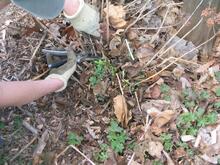URBANA, Ill. – After the 2019 growing season, there is likely leftover landscape clean up needed besides the usual spring yard work.
“Early cold weather and rain shut down a lot of clean up last fall,” says Richard Hentschel, University of Illinois Extension horticulture educator. If the cold weather and rain were not enough, the unexpected very cold weather surprised many trees, leaving lots of foliage dead, but hanging on, to come down later.
Leaf cleanup will be a combination of those leaves you intentionally left as mulch to protect tender perennials and newly fall-planted items and late falling leaves.
“Do not uncover the perennials too early, exposing them to yet cold temperatures and the rabbits,” Hentschel says.
Winter snow loads and spring winds will contribute to the small branches and twigs on the lawn. If you have the chance, pick them up and add them to the outdoor fire pit so they do not interfere when raking the lawn.
Do not overdo that first effort to clean up the lawn. The idea is to get the initial debris off the lawn while not removing any of the tender green grass. Remember, each grass plant has been pushed up from freezing and thawing and needs time to get those roots firmly back into the soil, Hentschel says. "Nothing mechanical here, just the leaf rake for now."
While waiting on the lawn to dry more, consider some necessary pruning in landscape beds. The warm-season perennial grasses left up for the winter should be pruned down before growth resumes. Use a bungee cord to pull the top growth together to make the cut back easier and not as messy as removing a few grass stalks at a time.
All the matted foliage from daylilies and hosta can be cleaned. "Be gentle with hosta," Hentschel says. "The new buds for this year are going to be just underneath in the center, so use your hands rather than a rake."
While the flowering shrubs are still dormant in the home landscape, pruning out any dead and winter-damaged branches is going to be easier too. “Dead and damaged branches are easy to spot,” Hentschel says. “Color is a giveaway.”
Dead and damaged branches are always going to be a different color than the rest of the healthy branches in the canopy. Other shrubs needing attention are landscape roses that have been damaged over the winter. Prune away damaged canes until you see good green color. It is okay to gently reshape the whole landscape rose so new growth comes out evenly.
“While it might be tempting to do some digging in the dirt, it is better to wait on that until the soils are drier so soil structure is not destroyed and you just end up with lumps and clods of soil later,” Hentschel says.
University of Illinois Extension is the flagship outreach effort of the University of Illinois at Urbana-Champaign, offering educational programs to residents of all of Illinois' 102 counties and far beyond. Illinois Extension provides practical education you can trust to help people, businesses, and communities solve problems, develop skills, and build a better future. Through our Agriculture and Natural Resources programs, Illinois Extension supports the economic viability and environmental sustainability of natural and managed landscapes and productive lands in Illinois. Horticulture program educators provide research-based information and training about gardening, fruits and vegetables, flowers, insects and diseases, composting, landscaping, and more.
News source/writer: Richard Hentschel, Horticulture Educator, Illinois Extension
